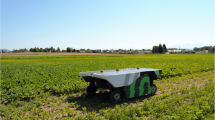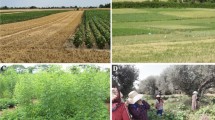Abstract
The technological advancements in agriculture have resulted in higher yields but lower ecological efficiency and nutritional value. Little innovations in later sectors such as integrating ecological functions in the production systems have crippled our agro-ecosystems to meet the ever-growing demands. The digitization of the agro-ecosystems has become the most essential entry point for any large scale sustainable developmental entities whether it is, crop diversification, sustainable intensification, input use efficiency, agronomic practices, to restoring ecosystem services and risk management. Recent advances in geoinformatics technology and big-data analytics enabled the diffusion of ecological functions in farm production to achieve the desired return (production follows functions). The overarching goal of the ongoing effort was to build an integrated farming system by leveraging technological diffusion with sound ecological functions to design an ‘inclusive agro-ecosystem’ for sustainable development. Meta-analytics of farming systems dynamics in spatial domains help quantifying changes, trajectories and drivers under changing climate, demography and degradation process to target site specific developmental interventions and scaling the proven technologies, such as intensification of food legumes in rice fallows, adoption of conservation agriculture, quantification of yield gaps, land/water productivity and transboundary cooperation.
Access provided by Autonomous University of Puebla. Download conference paper PDF
Similar content being viewed by others
Keywords
1 Introduction
Dry lands host an enormous variety of biophysical environments with extremely contrasting socio-economic and demographic conditions. This complexity leads to a wide variability in agricultural functions and productivity across spatio-temporal scales. Therefore, there is a definite need for an ecosystem-based approach for better managing natural resources to improve productivity in a sustainable way that integrates three main goals—environmental health, economic profitability, and social equity. Enormous efforts are underway to gather data and information on agricultural production and related aspects at various scales (http://bigdata.cgiar.org/). There are hundreds of data, tools, apps and much knowledge available for the increasing productivity but in silos, often without much focus on the ecological functions. There is need for meta-analysis of the best practices with diffusion of ecological functions for designing demand-driven, location-based sustainable agro-ecosystems for resilient livelihood in dry areas.
2 Approach
The dry areas represent a wide agro-biodiversity and the origin of climate resilient crops. However, in the last few decades, the productivity was a major driver rather than functional systems which resulted in the loss of agro-biodiversity in the farming systems. Production follows function and functional agricultural systems are by far more productive and sustainable than dysfunctional systems such as few commodity oriented or mono-cropping systems over long term. This requires dramatic transformational changes from mono systems to multi-cropping systems and re-design of the present agricultural landscape with functional metrics. This entails the systematic quantification of the agricultural production systems and farm analytics at multiple scale(s) with a wide array of data sources to design science-based innovative strategies and principles for inclusive multifunctional agro-ecosystems that are both sustained by nature and sustainable in their nature (Tittonell 2014). The effective use of integrated data in geospatial domains help develop ecological-intensification design eco-zones with location specific crops/varieties, crop sequence, rotation, intensity and crop water productivity (Biradar et al. 2009; Low et al. 2017) under a variable and uncertain climate. Such ecologically balanced agricultural production systems (agro-ecosystems) contribute to the UN’s Sustainable Development Goals (SDGs).
3 Use Cases
Several ongoing efforts are made by leveraging the big-data analytics to build use-cases, quantify the agricultural dynamics and understand the variability and drivers for sustainable production systems. Project based site specific studies have been undertaken in different agro-ecologies across the dry areas (http://geoagro.icarda.org/); such as intensification of food legumes in rice fallows in South Asia, adoption of conservation agriculture practices in North Africa, quantification of yield gaps and land degradation in central Asia, trans-boundary land/water productivity at river basins. Here we presented one use-case on ‘sustainable intensification of the rice fallows in India as an example and other use-cases can be found in the dedicated portal (http://geoagro.icarda.org/intensification).
3.1 Sustainable Intensification of Rice Fallows
As agricultural production, supply-demand gap continues to rise, the total arable land area is not expected to increase significantly, and future increase of agricultural production will depend more upon sustainable intensification of crop fallows. One such intensification opportunity lies in the use of rice fallows. At present, nearly ~11 million ha rice-fallows are left unproductive. Such large-scale agricultural intensification needs up-to-date information on the dynamics of the rice-based production systems, farm typology, crop and variety specific suitable areas, natural resource base and value chains. Such requirements have led to the development of digital agricultural platform designed to help intensification and crop diversification in crop fallows with food legumes. The digital interactive platform help analyze the farming systems, patterns, dynamics of the crop fallows, length of fallows duration, the start and end of the fallow periods, their seasonality, cropping intensity, etc. helping target sustainable intensification of the legumes crops in the rice fallows with multiple benefits to farmers as well the environment (Fig. 1).
4 Towards Restoring Lost Agro-Ecosystems
Loss of soil health coupled with increasing temperature and water scarcity remain key factors for determining sustainable agricultural productivity and the agri-food systems future. Agriculture production at present relies solely on few crops predominantly under monocultures of industrial agriculture. However, there are still many traditional farming systems with wide array of practices and production functions, which supports the resilience of agro-ecosystems (Altieri et al. 2015; Mehta 2017). The diversified agro-ecosystems is found to be more productive, helps in bridging the yield gaps, more sustainable and resilient to extreme climate events (Astier et al. 2012; Gaba et al. 2015; Low et al. 2018). A regular, accurate and cost effective spatial monitoring of rice-based production systems with satellite data made it feasible to target specific legume intensification. It provides spatially explicit information retrieval about crop productivity, pattern, inter and intra seasonal as well as farm variability which helps develop integrated agro-ecosystems. Such principles need to be embedded in various farm practices and agricultural development strategies, where each one has different effects on productivity, stability and resiliency within the farm system. The digital technology would play key role in an effective diffusion of sustainable agro-ecosystems and targeting a wider and faster adaptation to changing climate and demography. Finally, only by creating policies endorsed diffusion of digital technology that integrates ecological functions with economic and social welfare can we promote the adoption of sustainable agricultural systems across the scales.
References
Altieri, M., Nicholls, C., Henao, A., Lana, M.: Agroecology and the design of climate change-resilient farming systems. Agron. Sustain. Dev. 35, 869–890 (2015)
Astier, M., García, L., Galván, Y., González, E., Masera, R.: Assesing the sustainability of small-farmer natural resource management systems. A critical analysis of the MESMIS program (1995–2010). Ecol. Soc. 17(3), 25 (2012)
Biradar, C.M., Thenkabail, P.S., Noojipady, P., Yuanjie, L., Dheeravath, V., Velpuri, M., Turral, H., Gumma, M.K., Reddy, O.G.P., Xueliang, L.C., Xiao, X., Schull, M.A., Alankara, R.D., Gunasinghe, S., Mohideen, S.: A global map of rainfed cropland areas (GMRCA) at the end of last millennium using remote sensing. Int. J. Appl. Earth Obs. Geoinf. 11(2), 114–129 (2009)
Gaba, S., Lescourret, F., Boudsocq, S., Enjalbert, J., Hinsinger, P., Journet, E., Navas, M., Wery, J., Louarn, G., Malézieux, E., Pelzer, E., Prudent, P., Lafontaineet, H.: Multiple cropping systems as drivers for providing multiple ecosystem services: from concepts to design. Agron. Sustain. Dev. 35(2), 607–623 (2015)
GeoAgro Homepage. http://geoagro.icarda.org/. Accessed 14 May 2018
Low, F., Biradar, C., Fliemanna, E., Lamers, J., Conrad, C.: Assessing gaps in irrigated agricultural productivity through satellite earth observations - A case study of the Fergana Valley, Central Asia. Int. J. Appl. Earth Obs. Geoinf. 59, 118–134 (2017)
Low, F., Biradar, C., Dubovyk, O., Fliemann, E., Akramkhanov, A., Vallejo, A.N., Waldner, F.: Regional-scale monitoring of cropland intensity and productivity with multi-source satellite image time series. GIScience Remote Sens. 55(18), 539–567 (2018)
Mehta, M.H.: Eco Agri Revolution: Practical Lessons and The Way Ahead. New India Publishing Agency—Nipa, New Delhi, India (2017)
Tittonell, P.A.: Ecological intensification of agriculture—sustainable by nature. Curr. Opin. Environ. Sustain. 2014(8), 53–61 (2014). https://doi.org/10.1016/j.cosust.2014.08.006
Author information
Authors and Affiliations
Corresponding author
Editor information
Editors and Affiliations
Rights and permissions
Copyright information
© 2019 Springer Nature Switzerland AG
About this paper
Cite this paper
Biradar, C. et al. (2019). Digital Diffusion for Inclusive Agroecosystems. In: Chenchouni, H., Errami, E., Rocha, F., Sabato, L. (eds) Exploring the Nexus of Geoecology, Geography, Geoarcheology and Geotourism: Advances and Applications for Sustainable Development in Environmental Sciences and Agroforestry Research. CAJG 2018. Advances in Science, Technology & Innovation. Springer, Cham. https://doi.org/10.1007/978-3-030-01683-8_2
Download citation
DOI: https://doi.org/10.1007/978-3-030-01683-8_2
Published:
Publisher Name: Springer, Cham
Print ISBN: 978-3-030-01682-1
Online ISBN: 978-3-030-01683-8
eBook Packages: Earth and Environmental ScienceEarth and Environmental Science (R0)





